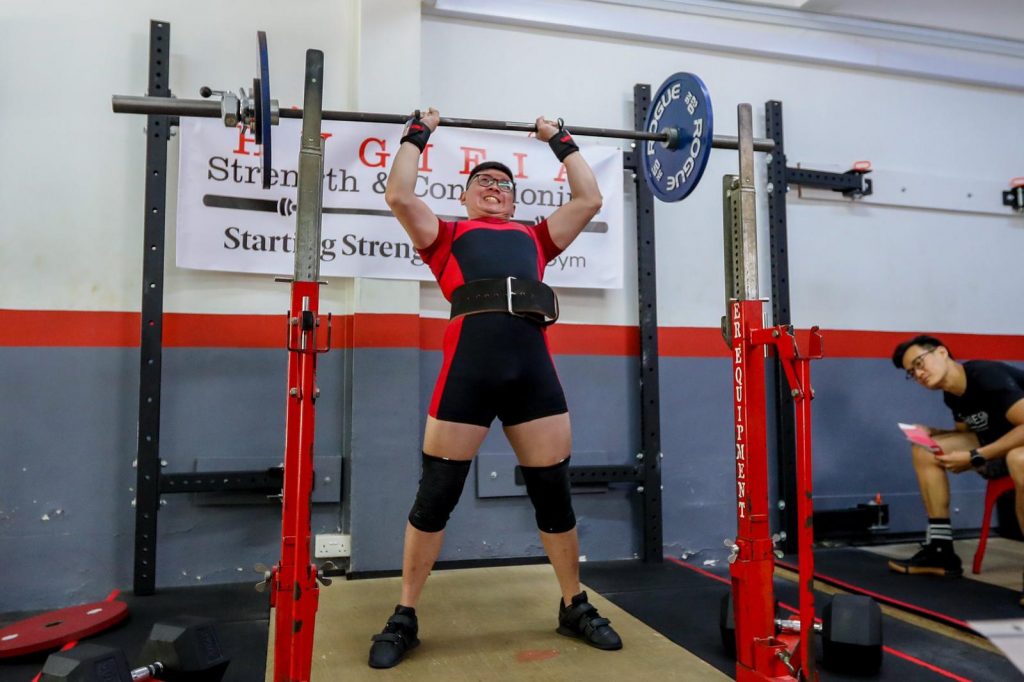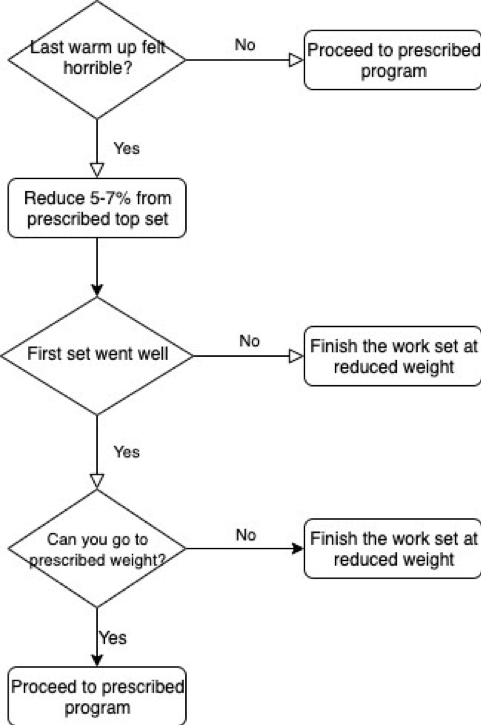14 January 2020
4:00 am
My newborn daughter cries for her milk. She has been my morning alarm for the past two weeks. This process has been repeating every 3 hours and thus our maximum amount of uninterrupted sleep is around 3 hours.
3:00pm
I officially failed all lifts in my training today.
There will be times when our training schedule gets disrupted. Life happens and will disrupt our training schedule and it’s quality. It can be anything! From having a baby to work or just some other external factors that can disrupt your regular training performance. Depending on the severity of the disruption, I can suggest a few tips and tweaks that you can consider in your training.
These measures are presented in steps from the most essential factors to detailed ones such as programming. You’re advised to try each step one at a time, starting from step 1. If following up to step two solves your issue, stop there, you don’t need to continue to the next step. The further down you are, the more compromises you need to make to your training.
Step 1: Manage the first three questions
When to apply: whenever you feel too exhausted before training, whenever your training doesn’t go very smoothly
When not to apply: N/A – always applicable!
1. How long are you resting in between sets?
2. How big is the weight increments in between training?
3. Do you have enough food and sleep for recovery in between training?
These three questions are normally observed in the case of abrupt ending in the linear progression, but the same concept can be applied. The third question about the recovery will be our primary concern. Just ensure to the best of your ability that you can take sufficient rest and food intake that mimics your habit during a normal period.
At this period of time, your training might feel more difficult compared to a regular workout. Keep the training according to your prescribed program. Take more rest in between sets if necessary (the first question), and if you are still in the linear progression, you can take smaller jump just this once.
Step 2: Moving training days up/down
When to apply: when you can’t train during your regular training days because of an external factor (i.e. planned event, unplanned emergency overtime, recovering from sickness)
When not to apply: when you have a normal routine, but you don’t feel “recovered” from your previous workout
Consistency is one of the biggest factors in training and should not be mismanaged by continually extending the gap between training just because you don’t feel 100%. A general principle to move up/down the training days is to ensure the number of training days per cycle is consistent.
Sample case #1 for Novice to Intermediate lifter (Difficulty level: Easy)
You have a regular Monday/Wednesday/Friday training schedule. This week, an important event on Wednesday prevents you from training.
Solution:
You can move your training to Thursday and Saturday.
| M | T | W | Th | F | S | S |
| Training | Important event | Training | Training |
Alternatively, you can also move the Monday and Wednesday earlier to Sunday and Tuesday. This iteration normally works better for me because it gives a gap day after the event, thus less concern for fatigue or exhaustion from the important event.
| Sun | M | T | W | Th | F | S |
| Training | Training | Event | Training |
Sample case #2 (Difficulty level: Medium)
You couldn’t train on the previous Sunday, and you have something on from this week Friday to Sunday.
| M | T | W | Th | F | S | S |
| Training | Training | Event/
Can’t train |
Event | Event |
Novice case: Train two times only for this week, and ensure to get back to a normal training schedule next week. You can adjust your Wednesday training day to Thursday to lessen the gap between your last training of the affected week to the following week. This is not ideal as we will compromise 1 training day, but we can normalize the stress by increasing the volume to 4×5 instead of the regular 3×5. For deadlift, we can do 2×5 instead of 1×5 per workout.
| M | T | W | Th | F | S | S |
| Training + volume | Training + volume | Event | Event | Event |
Intermediate case: You will still need to train 3x per week and arrange the training days based on the load distribution. For example, if you have your regular heavy days on Friday, you can train on Monday-Tuesday-Thursday instead of Monday-Wednesday-Thursday. However, if your program follows a variation of HLM with the heavy day on the first day, you can combine the two lesser stress day in the end.
A. Texas Method:
| M | T | W | Th | F | S | S |
| Training Volume | Training Light | Training Heavy | Event | Event | Event |
B. Heavy-Light-Medium (HLM):
| M | T | W | Th | F | S | S |
| Heavy day | Light day | Medium day | Event | Event | Event |
Step 3: Managing the intra-workout load
When to apply: during a prolonged stressful period that might affect you for more than 1 week, but you can follow the main structure of the program
When not to apply: during novice phase; during a transmutation or realization block (unless you are using RPE scheme for your training, please consult your coach)
Once step 1 and step 2 are exhausted, it will be more on a case by case basis. The main goal here is to manage the stress to a level that you can handle without changing the structure of your training. In such a case, I’d advise my lifter to use my prescribed load as a rough guideline and let them work within 5-7% of the prescribed load.
Sample case:
Prescribed program: (Squat) 125kg x 5 reps; 112.5 x 5reps x 2 sets
You have been very busy for the past 10 days. You did your last warm-up at 110kg and it moved very slowly.
Sample solution: You can try to reduce 5% from the top set to 118.5kg x 5 and judge whether another set of 125kg x 5 is possible. If you are able to do 125kg x 5, you can omit 1 back off set of 112.5kg. If 118.5kg is really the maximum you can do for the day, immediately proceed to the back offs with 5% reduced weight.
Figure 1 Logic chart in managing intra-workout load
Step 4: Deload and adjustment in the training program/structure
When to apply: during severe lifestyle changes / new environment with prolonged effect (relocation, new job, new-born baby), inability to manage recovery factors, a severe drop of training compliance due to factors you can’t control
When not to apply: when you haven’t exhausted all previous steps
Training quality in this situation is never ideal, thus the main approach towards training at this stage will be to prevent detraining during this transition period. It’s very important for the whole program to match the amount of training commitment one can undertake, even by toning down the training to its barebones.
For novice lifters, you can take this situation to do an intentional deload of 10-25% depending on the severity of the case. It’s okay to deload quite significantly at this point in time. You can still regulate the jump in between training to be bigger when you feel better or smaller on the bad days.
For intermediate lifters and above, higher intensity and higher amount of sets might not be ideal at this point. I’d focus on the main lifts or several supplemental lifts that give longer time under tension at a lighter weight and/or higher amount of reps. For example, tempo squats for 2-3 sets of 6-8.
It’s also good to let the lifter decide their suitable weight to begin this kind of program. For example:
Ramp-up sets of 5 for paused squat up to a weight that is moderately hard. Do two sets at the heaviest weight.
This will let you do a little bit more volume during warm-ups as you find a suitable weight. Then for the following training, you can increase by 2.5kg to 5kg depending on how you feel. For example:
Ramp-up sets of 5 for paused squat up to a weight that is moderately hard. Do two sets at the heaviest weight. Try to beat your previous training by 2.5-5kg.
There are still plenty more nuanced ways to manage your training around the external stress factor. However, I’d like to recommend anyone to maximize their recovery factors first, and then make smaller adjustments to their training. Try to execute everything based on the initial program before considering to make any changes to the program itself. In the end, any amount of training, no matter how much it’s scaled-down, will be better than fully giving up. And if you have stopped for a while, let’s start again.



